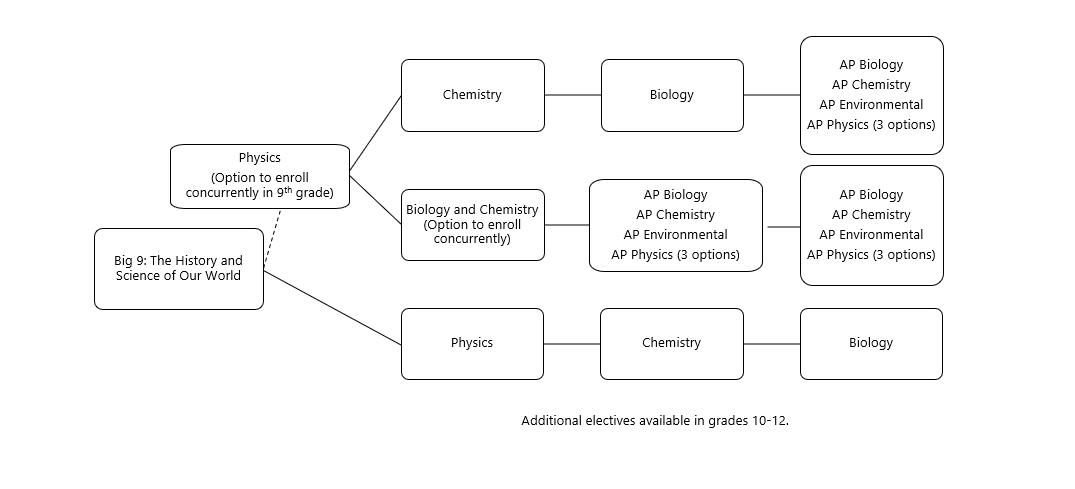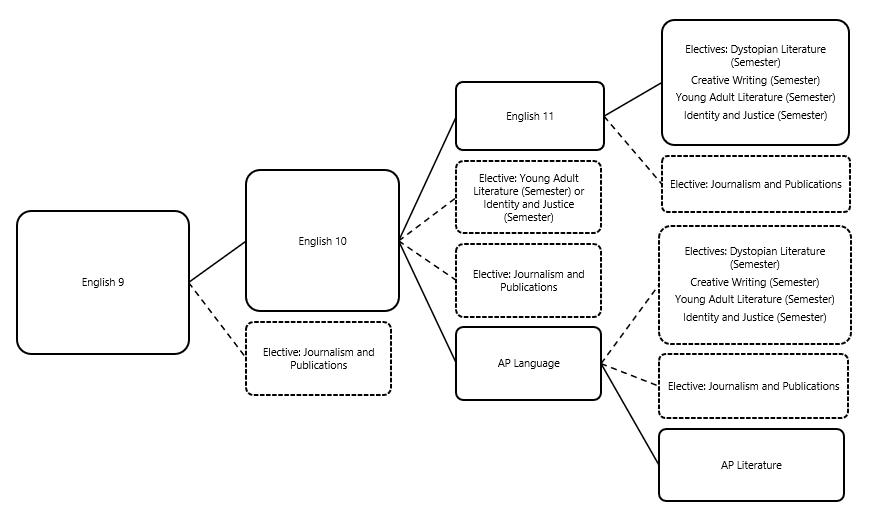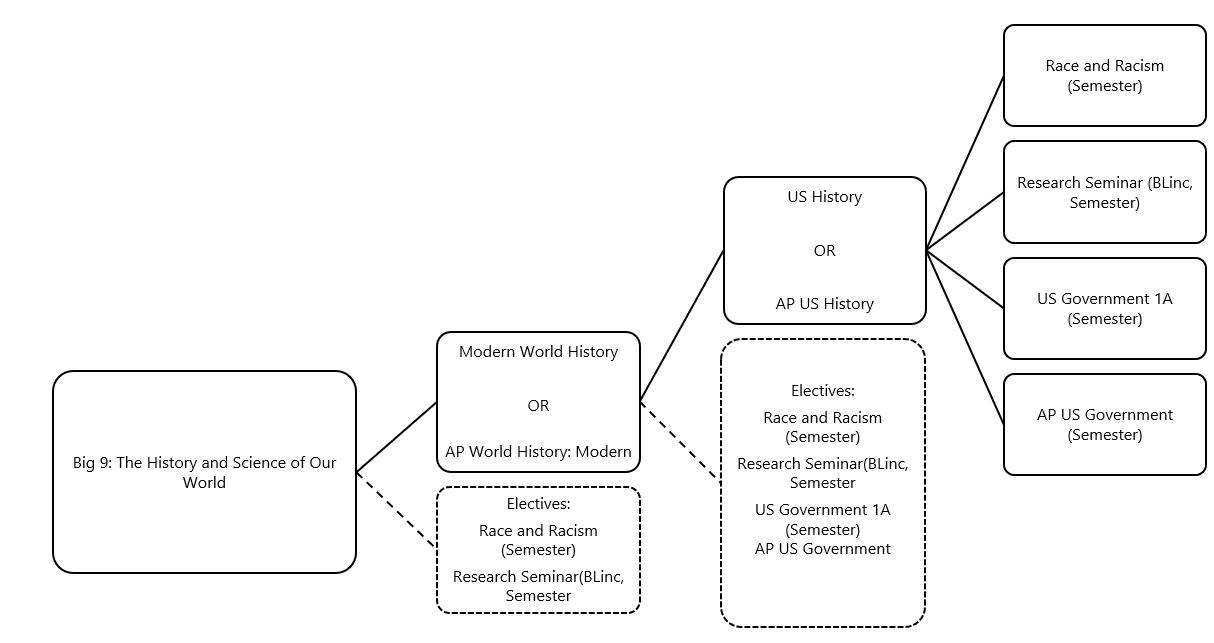
10 minute read
POLICIES
Note: these policies will be reviewed before the 2021-22 school year and are subject to modification.
Course Load Students are required to take a minimum of five courses each semester and may take up to six courses. This does not include X-block courses. Students who take five courses are assigned “GTD: Get Things Done” time for their sixth block in the schedule, which is the equivalent to a study hall. Permission to take fewer than five courses in a semester needs to be approved by the Upper School Principal, as does permission to take more than six. Occasionally, students may wish to take an Independent Study, BLinc, or Global Online Academy elective as a seventh course, which is recommended only under specific circumstances and requires Principal approval. Students who enroll in the Learning Support 4-5 day/week program should take five courses at a time so as to have room in their schedule for individual coaching.
Advertisement
Course Selection Students will partner with their academic advisors, grade-level dean, and college counseling team to determine the appropriate course of study for a student. Additional instructions will be provided to students during their advisory and class meetings.
Blended Learning at Indian Creek (BLinc) Blended Learning at Indian Creek (BLinc) enables students to have flexibility and choice in their pace of learning. These courses are predominantly asynchronous in nature with ICS instructors leading the courses. Course materials will be posted each week and students will determine the pace and path in which they work the material. In addition to the asynchronous work, multiple check-ins are integrated into the weekly experience so students can stay connected and on target with the course’s learning goals. Synchronous opportunities provide time for students to collaborate with their peers and teacher. Synchronous experiences will be scheduled at a time that is mutually convenient for the teacher and students including meetings during lunch, X-block, or alternate time frames. The course load expectations are comparable to other ICS courses.
Global Online Academy Courses Through Indian Creek School’s partnership with the Global Online Academy, ICS students have access to online, asynchronous courses with teachers and students from around the world. Students may choose to take a Global Online Academy (GOA) course as either a fifth or sixth course with approval. Students who wish to take a GOA course should write it in their course selection form. ICS will pay for the first course a student enrolls in each school year. After the first course, the family is responsible for the tuition of $600. If a student chooses to take a Global Online Academy Course as the seventh course, the family is responsible for the
tuition of $600. Students must have their Global Online Academy course choice approved by the GOA Site Director.
Add/Drop Policy Students wishing to add or drop a course once the semester has started should reach out to their academic advisor for guidance in making the change. Global Online Academy and BLinc courses may be dropped within one week of beginning without penalty; otherwise, families will be responsible for the course fee.
Course Cancellation A course may not run if it does not reach the minimum enrollment requirement. ICS intentionally offers more courses in the Curriculum Guide than can be offered so as to develop a course offering based on student interest. When courses are not offered, students are placed in one of the alternate courses indicated on their course selection worksheet.
Marking Periods The academic year is divided into two semesters. Students will receive academic reports at the end of the first quarter, first semester, third quarter, and fourth semester.
Course Length and Credit Unless noted as a semester course, all courses run the length of the academic year. Yearlong courses are awarded one academic credit and semester courses are awarded a half of an academic credit
Academic Advising
Starting in Grade 9, students are paired with an academic advisor whose responsibility it is to know and support each of their advisees and families on their ICS academic journey. Advisors are the first point of contact for students and families, and the first layer in our student support network. Academic advisors partner with teachers, deans, and college counselors at school and with parents/guardians at home in supporting their advisees.
Academic Honesty
All students are expected to live up to the highest standards of academic honesty. Cheating on a test or quiz or plagiarism in any manner will result in consequences that may include a reduction in grade, a zero on the work, and even suspension or expulsion.
Plagiarism consists of the following behaviors:
• Copying word for word or almost word for word from another’s published or unpublished work. This includes everything from downloading material from the Internet and claiming it is as one’s own work to copying someone’s homework. • Copying ideas without giving credit. Accidental plagiarism is still plagiarism.
Grading Policies
Indian Creek School uses CREEKnet as the learning management platform to house all student data including contact information, schedules, grades, and transcripts. CREEKnet provides a portal for students and parents/guardians to access current grades for students. Upper School will report grades at the conclusion of quarters and semesters for all students.
In general, grades will be recorded in categories that may include:
• Homework (work assigned to be completed outside of class) • Assignments (shorter work as part of a lesson or unit) • Projects (individual or group work, presentations) • Quizzes (formative assessments in various forms) • Tests (summative assessments in various forms) • Classwork and Participation* (such as a discussion or lab)
Individual teachers will use the categories appropriate for the class and class work. Teachers use their discretion to decide which of the above categories to use the value and weight for assignments.
Indian Creek School does not calculate a class rank. Students earn grades of A through F, modified by pluses and minuses. Grades for AP courses are weighted a full point. Students who earn a GPA of 3.6 or above are named to the Dean’s List. Students who earn a 4.0 or higher are named to the Head’s List.
Grading Scale
GPA Calculation

Upper School Schedule
At Indian Creek, we treat time as a sacred resource, and our schedule is designed to maximize student engagement, mental and physical wellbeing, opportunity, and learning outcomes.
A later start to the day - right for teenagers, backed by research. Students arrive on campus at 8:40, with an extra 20 minutes to sleep in on Wednesdays. This late start allows students to get more sleep, which their bodies and brains need. We use the extra time in the morning for faculty collaboration and professional development, and office hours for students who would like extra help, either in-person or virtually from home via our video conferencing platform.
What the research says: "High schools that start at 8:30AM or later allow for more than 60% of students to obtain at least 8 hours of sleep per school night. Teens getting less than 8 hours of sleep reported significantly higher depression symptoms, greater use of caffeine, and are at greater risk for making poor choices for substance use. Academic performance outcomes, including grades earned in core subject areas of math, English, science and social studies, plus performance on state and national achievement tests, attendance rates and reduced tardiness show significantly positive improvement with the later start times of 8:35AM or later. Finally, the number of car crashes for teen drives from 16-18 years of age was significantly reduced by 70% when a school shifted start times from 7:35AM to 8:55AM."
Source: Wahlstrom, K., Dretzke, B., Gordon, M., Peterson, K., Edwards, K., & Gdula, J. (2014). Examining the Impact of Later School Start Times on the Health and Academic Performance of High School Students: A Multi-Site Study. Center for Applied Research and Educational Improvement. St. Paul, MN: University of Minnesota.
Class length and frequency
Most classes meet either 3 or 4 times a week for 60-minute periods. Total instructional time per week averages just above 200 minutes, which aligns with what high school schedule consultants (yes, that is a thing!) recommend.
Each day contains five, one-hour blocks in addition to community time and lunch. These 1-hour blocks are the "just right length" for the kind of teaching and learning we do at ICS. We find the typical 40-minute period to be too short to really get into the material. And while more than 60-minutes can be useful for certain labs and projects, it is also easy to lose interest when you go much longer than an hour. So, we have flex periods in place to expand class into when more time is justified. Our teachers design lessons with 60 minutes in mind. No single class is spent doing the same thing the whole time.
Homework Policies & Total Time
At ICS, work is divided into "synchronous" and "asynchronous" activities. Synchronous work is done together with classmates and teachers (direct teacher instruction, class discussion, group work, etc.). Asynchronous work is done by students independently, either during the class period or as homework.
In addition to students' work during the 60-minute class period, they may be assigned up to 20 minutes of asynchronous work to be completed outside of class, or 40 minutes for upper and AP level courses. Additional work may not be assigned on days when classes drop. This means a maximum of 80- or 100- minutes of work per day when a class meets.
Adequate notice of assignments and timely feedback on student work is essential to learning and good teaching practice. We expect our students to prepare in advance and complete work on time and understand the importance of our faculty demonstrating this respect for learning as well. Teachers follow these guidelines regarding assignments:
• Daily Homework (ex: nightly math problems, a written paragraph, a few reading questions): Daily homework/asynchronous assignments will be posted by the end of the class period during which they are assigned and returned to students (with grades posted to CREEKnet) within 2 business days of the due date. Teachers expect students to turn in their assignments by the assigned due date and time.
These assignments must abide the time limits described above. • Quizzes, multi-day assignments, smaller assessments (ex: reading quiz, math quiz, squares of numbers, periodic elements, etc.): These types of assignments must be posted to CREEKnet three days in advance of the due date and will be graded and returned to students (with grades posted to
CREEKnet) within 2 business days of the due date. Preparation for these assignments needs to be factored into the time limits described above.
• Larger Assessments and Projects (lab reports, multi-page papers, tests/exams): Major assignments should be posted to CREEKnet at least a week in advance of the due date and will be graded and returned to students (with grades posted on CREEKnet) within one week. Note: There are some exceptions to this (much longer papers, lab reports, etc.). These major assignments may require
students to spend more time than the total work time limits described above, and students should seek support and guidance from their advisor and teachers when this presents undue challenge.
Why do we put time limits in place for assignments? It's about balance. There's a lot of research out there on the diminishing returns of homework after a certain amount of time, and there's also a lot of research out there that suggests that high school students are often over-worked and over-stressed. ICS students have rigorous classwork that stretches and challenges them, and yet, we don't think it is fair or right to expect our students to stay up until the wee hours of the morning just to be able to do what is expected of them. Many of our students have active commitments in the arts, athletics, service learning, and participation in activities outside of school.
GTD: Get Things Done
Students who take 5 classes have GTD time most days, and students who take 6 classes still have GTD time once or twice each week. Students use GTD time for whatever they need: a snack, time in the Academic Resource Center getting homework done, a workout in the fitness center, meeting with their college counselor, time with a Learning Lab coach developing study strategies, meeting with a teacher, etc. Grade 9 and 10 students are assigned to a classroom or the Learning Lab for their GTD time and may sign out with the teacher on duty to go elsewhere. After the first semester of Grade 10, students may earn the privilege of managing GTD time on their own.

UPPER SCHOOL DAILY SCHEDULE





